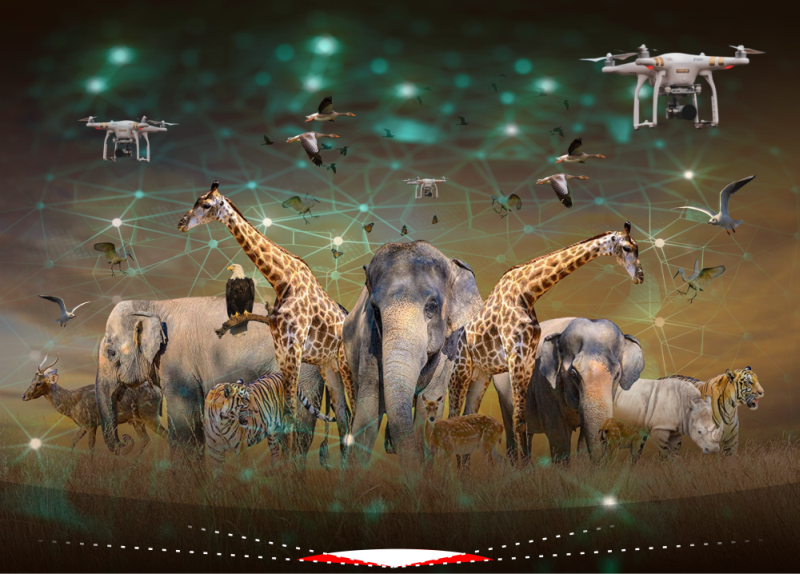Artwork by Vikash Khatri

Mayanglambam Pooja Devi
The relationship between humans and nature has increasingly become unequal and exploitative. Man has caused immense environmental destruction such as habitat degradation, overexploitation of natural resources, human-wildlife conflicts, illegal trafficking and much more. Our planet is losing its biodiversity at an unprecedented rate. A recent report by the World Wildlife Fund (2020), suggests that since 1970, more than 20,000 populations of mammals, birds, amphibians, reptiles, and fish have decreased on average by 68%. Several of these creatures are essential to the functioning of entire ecosystems. Given the rate of wildlife population decline, its conservation is of pivotal importance. Thankfully, the use of technologies in this field offers a glimmer of hope. One such advancing technology is Artificial Intelligence (AI). AI is a branch of computer science and technology that develops intelligent machines and computer programs to accomplish tasks that otherwise require human intellect. We could productively think of AI as a man-made brain. Now, how does AI contribute to wildlife conservation?
Technologies like AI-enabled drones, also known as, unmanned aerial vehicles (UAVs), are changing the dynamics of wildlife conservation. A UAV is a simple plane that does not have a human operator, crew, or passenger aboard. It provides an adaptable, accurate, and cost-effective answer to the technical issues involved in law enforcement and conservation management. UAVs are equipped with a photography system and AI software (Machine Learning) that allow the operator to plan a pre-programmed flight. UAVs collect remote-sensing data at fine temporal and spatial scales. With the help of drones, researchers can acquire a large volume of image-based data from a wide variety of habitats including those that are difficult to access on foot. In comparison to manned aircraft, most UAVs are smaller and quieter, making them a more non-intrusive option for performing wildlife surveys.
AI-enabled drones were first used in Kaziranga National Park to monitor rhino poachers. As of now, there are three drones in the park, two of which are with the Kaziranga police department, and one with the forest officials. Coordinated by Tata Consultancy Services (TCS), these UAVs are now patrolling the 430 square km National Park. The UAVs are fitted with infrared imaging cameras to track poachers operating at night, allowing better vigilance of nighttime activities. The drones can stay in the air for 40 minutes and the images they capture can be monitored in real-time. In this way, AI-enabled UAVs help reduce the difficulties faced in wildlife monitoring.
AI is also playing a significant role in conserving species that are on the verge of extinction. Numerous AI-based applications are being used to meet the Sustainable Development Goals (SDG), namely SDGs 14 and 15 (SDG 14 and 15 aim to conserve, restore, and promote sustainable use of ‘life below water’ and ‘life on land’, respectively). Scientists are evaluating data linked to the number and well-being of whales utilising marine robots, remote–sensing, and machine learning models on Microsoft Azure. Environmentalists are using AI with predictive statistical modelling to monitor Antarctic penguins on a real-time basis. WWF and Intel are working with academics on a mission to use artificial intelligence to preserve Siberian tigers in China. AI can thus be beneficially used by researchers to identify an animal's location, the time and date of its observation, patterns of migration, relative abundance, and even its social milieu. AI-enabled gadgets, software, and surveillance systems are employed to follow and comprehend animals' repetitive behaviours, such as reproductive patterns, feeding routes, and hunting routines.
Another way in which AI is aiding conservation efforts is by preventing wildlife-vehicle collisions. To minimise the collisions, big mammals and pedestrians are detected through thermal cameras coupled with a radar, a visual sensor, and a convolutional neural network (CNN). Given a set of real-world photographs or videos, this AI model learns to automatically generate the properties of the inputs to achieve a given goal, such as image, object, or face identification. One such technology is StradVision (a pioneer in AI-based vision processing technology for autonomous vehicles) which is modelled on deep-learning-based SVNet software.
AI can also help predict wildfires. There are several AI programs that analyse high-resolution satellite images to forecast the intensity of burning of wildlife and then coordinate with the data to help in fire prediction.
Furthermore, AI can be effectively deployed as an early poaching warning system.: WildEyes is one such system which uses simulated data models to track mammals such as elephants and rhinos. AI algorithms are also designed to spot which species or wildlife features, such as horns or scales, exist in a picture or video, while also identifying the environment in which they appear, such as a natural habitat or a market.
While AI has the capacity to be a helpful tool for wildlife conservation, there are some challenges to be considered. Drones are limited by the very qualities that make them desirable. They have limited durability, and any technical error might lead to a complicated and expensive crash. Due to the complications involved in the use of thermal imaging technology, they might be difficult to operate. In India, where staff members struggle to access minimal requirements such as proper footwear and attire, drone use still has a long way to go. Such technologies can also result in a bad relationship between locals and conservation authorities if they are not introduced to the technology properly. Especially, when they are used in remote regions of developing countries where people have had little prior exposure to electronic devices, such technologies may give rise to doubts, conspiracy theories and suspicions. As a result, the introduction of "responsible AI," which outlines general ethical approval procedures and provides relevant advice on an algorithm and its limitations, is something that can be advocated. And for that, conservationists, AI researchers, and local communities need to work hand in hand.
Clearly, AI technologies are making a significant impact in the domain of wildlife conservation. Due to the development of several services for AI, conservation efforts are now noticeably more informed and effective. AI brings to light various ways of protecting life forms by delivering massive data on what is happening to wildlife. With its advancements, there are many exciting possibilities available now. However, it will only be beneficial if the AI models are efficiently trained using the appropriate machine learning sets of data. As humans learn to balance their progress with the requirements of wildlife, AI tools have arrived at a favourable time to enable sustainable coexistence between humans and animals. It is therefore crucial to conduct further research into AI as a revolutionary solution to environmental challenges.
The writer works as a Teaching Fellow at Plaksha University





